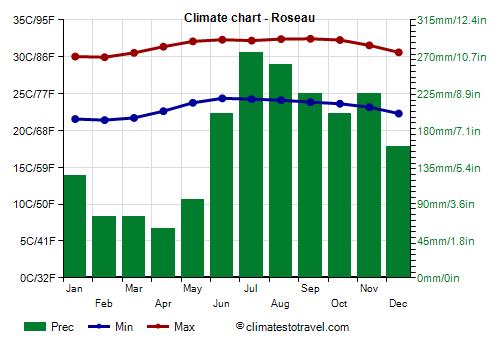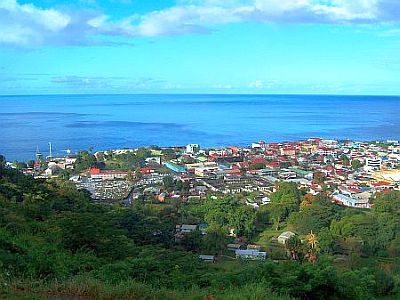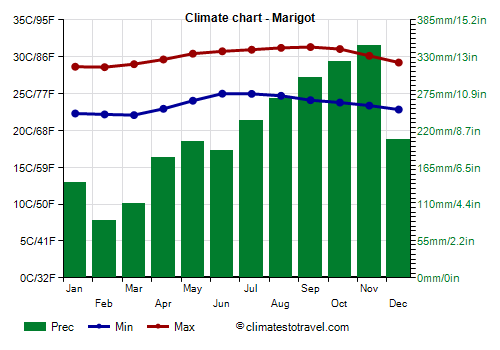Select units of measurement for the temperature and rainfall tables (metric or imperial).
Average weather, temperature, rainfall, sunshine
Dominica, an island of the Lesser Antilles located at 15 degrees north latitude and belonging to the Commonwealth, has a
tropical climate, hot and humid all year round, with a relatively cool and dry season from January to mid-April and a hot, humid and rainy season from mid-June to mid-November.
In the former period, the
northeast trade winds, constant winds typical of tropical climates, blow steadily and with moderate intensity, while in the latter period, these winds are more irregular, and may have some breaks, increasing the feeling of sultriness.
Between them, there are two
transitional periods: from mid November to early January (when the northeast wind starts to blow, the temperature decreases a bit, and the weather gets better) and from mid-April to Mid-June (when both the temperature and the frequency of downpours gradually increase).
Rainfall is abundant: on the west coast, 1,700 millimeters (67 inches) of rain fall per year. The east coast, directly exposed to the trade winds, is even more rainy, so much so that it receives 2,500 mm (98 in) per year. In addition, here daytime temperatures are slightly lower, around 1.5 °C (2.7 °F), and the humidity is higher.
The rains in Dominica occur throughout the year as
downpours or thunderstorms, which could be intense, but generally do not last long, so they do not reduce too much the
sunshine hours. Sometimes, however, there may be a more intense wave of bad weather. On average there are around 2,600/2,700 hours of sunshine per year.
In the interior of the island, entirely covered by
hills and mountains, the rains are even more frequent and abundant, in fact, there are rainforests, and the climate can be defined as equatorial. In the northern part of the island, we find
Morne Diablotins volcano, 1,447 meters (4,747 feet) high, which receives as high as 9,000 mm (354 in) of rain per year, while in the south, we find the Morne Trois Pitons National Park, a UNESCO World Heritage Site, where, in addition to an impenetrable jungle, we find geysers, rivers and waterfalls, as well as a hot lake, the Boiling Lake.
The climate in detail
The cities
Roseau

In
Roseau, the capital, located on the southwestern coast, the average temperature fluctuates between around 26 °C (79 °F) from January to March, to around 28 °C (82.5 °F) from May to October. As you can see, there are little variations between the coolest and the warmest period.
In Roseau, 1,735 millimeters (68 inches) of rain fall per year, of which more than 150 mm (6 in) fall per month from July to November. The least rainy period is from February to April, with less than 70 mm (2.7 in) per month.

Marigot

As mentioned, the eastern side, exposed to the trade winds, is rainier, and also slightly cooler, at least during the day.
In
Marigot, a town located in the north-east of the island, near Douglas–Charles Airport, 2,570 mm (101 in) of rain fall per year, with a maximum of 300 mm (11.8 in) or more from September to November, and a minimum of 85 mm (3.3 in) in February.
Sea temperature
The
sea in Dominica is warm enough to swim in all year round: the water temperature ranges from 26.5 °C (79.5 °F) in February and March to 29 °C (84 °F) in September and October.
Hurricanes
The greatest danger comes from tropical storms and cyclones, called
hurricanes in the Caribbean area, which may pass over the island from June to November, though they are most likely from August to October. Two hurricanes that have been particularly destructive on this island were David in late August 1979 and Maria in September 2017.
When to go
The best time to visit Dominica is from
February to April, since it is the least rainy period of the year. December and January are still quite rainy months, though less so than the period from July to November, which has the greatest risk of heavy showers and thunderstorms (as well as of hurricanes). It is worth while to recall that the west coast, where Roseau is located, is more sheltered.
What to pack
All year round: bring
light, tropics-friendly clothes of natural fabric, a sun hat, sunscreen, and possibly a light sweatshirt and a light raincoat for thunderstorms. From December to March, you can add a light sweatshirt for the evening.
When going to the reef, you can bring snorkeling equipment, including water shoes or rubber-soled shoes. When going hiking in the mountains, bring hiking shoes, a raincoat and a sweatshirt.
Climate data - Dominica
| Marigot |
|---|
|
| Jan | Feb | Mar | Apr | May | Jun | Jul | Aug | Sep | Oct | Nov | Dec |
|---|
| Min temp. | 22 | 22 | 22 | 23 | 24 | 25 | 25 | 25 | 24 | 24 | 23 | 23 |
|---|
| Max temp. | 29 | 29 | 29 | 30 | 30 | 31 | 31 | 31 | 31 | 31 | 30 | 29 |
|---|
| Precip. | 145 | 85 | 110 | 180 | 205 | 190 | 235 | 270 | 300 | 320 | 345 | 205 |
|---|
| Prec. days | 19 | 15 | 14 | 16 | 16 | 17 | 21 | 22 | 19 | 22 | 21 | 20 |
|---|
| Humidity | 75% | 73% | 72% | 73% | 74% | 75% | 76% | 77% | 77% | 78% | 78% | 76% |
|---|
| Day length | 11 | 12 | 12 | 12 | 13 | 13 | 13 | 13 | 12 | 12 | 11 | 11 |
|---|
| Sun hours | 7 | 8 | 8 | 8 | 8 | 8 | 8 | 8 | 7 | 7 | 7 | 6 |
|---|
| Sea temp | 27 | 26 | 26 | 27 | 28 | 28 | 28 | 29 | 29 | 29 | 28 | 28 |
|---|
| Roseau |
|---|
|
| Jan | Feb | Mar | Apr | May | Jun | Jul | Aug | Sep | Oct | Nov | Dec |
|---|
| Min temp. | 22 | 21 | 22 | 23 | 24 | 24 | 24 | 24 | 24 | 24 | 23 | 22 |
|---|
| Max temp. | 30 | 30 | 31 | 31 | 32 | 32 | 32 | 32 | 32 | 32 | 32 | 31 |
|---|
| Precip. | 110 | 65 | 45 | 65 | 90 | 160 | 230 | 250 | 245 | 180 | 175 | 125 |
|---|
| Prec. days | 16 | 13 | 10 | 10 | 11 | 16 | 20 | 20 | 16 | 17 | 15 | 16 |
|---|
| Humidity | 68% | 66% | 64% | 65% | 65% | 66% | 68% | 70% | 72% | 72% | 72% | 70% |
|---|
| Day length | 11 | 12 | 12 | 12 | 13 | 13 | 13 | 13 | 12 | 12 | 11 | 11 |
|---|
| Sun hours | 6 | 7 | 7 | 8 | 8 | 8 | 7 | 8 | 7 | 7 | 6 | 6 |
|---|
| Sea temp | 27 | 26 | 26 | 27 | 28 | 28 | 28 | 29 | 29 | 29 | 28 | 28 |
|---|